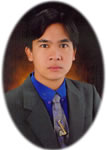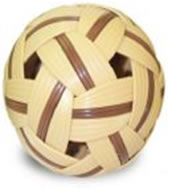
Bienvenido
B. Constantino, Jr. |
| SEPAK
TAKRAW and MAKABAYAN |
 |
After mentioning Sepak Takraw and Makabayan
in my previous article published in the
January
2008 edition of pelinks4u,
I wanted to further elaborate on these
exciting topics for readers from other
parts of the world that may not know about
them.
SEPAK TAKRAW
Sepak Takraw is said to have originated
in the Malay Peninsula (Malaysia) during
the 15th century, and was played in some
of its states and surrounding nations
including the Philippines. Sepak Takraw
has many different names depending on
the country: |
Sepak Takraw is becoming one of the most popular
sports included in the Southeast Asian Games.
The Palawan province is known for the best Sepak
Takraw players in the Philippines. Region IV-B,
also known as Mimaropa (Mindoro/Marinduque/Romblon
and Palawan provinces), has won consistently
in the Philippine national games (Palarong
Pambansa) due to its well trained players.
However, the sport has been dominated by Malaysia
and Thailand in the Southeast Asian Games since
its début in 1965.
Flexibility and agility are the primary skills
necessary to be successful in SEPAK TAKRAW.
The game is similar to volleyball, except hand
contact is not allowed. Included below are the
rules of SEPAK TAKRAW. The game begins with
a coin toss by the umpire to determine who serves
first.
players: It can be played
with only two teams (called "Regu")
consisting of three players each. Each "Regu"
is allowed at most three touches on the ball.
Players consist of the "Back" (player
on the back), "Left Inside" (player
on the left), and the "Right Inside"
(player on the right).
 sepak
takraw ball: The ball is made of natural
rattan or synthetic fiber. It consists of 9-11
strains, 12 holes, and 20 intersections. The
ball's circumference is 0.42-0.44m for men and
0.43-0.45m for women. It weighs 170-180 grams
for men and 150-160 grams for women. sepak
takraw ball: The ball is made of natural
rattan or synthetic fiber. It consists of 9-11
strains, 12 holes, and 20 intersections. The
ball's circumference is 0.42-0.44m for men and
0.43-0.45m for women. It weighs 170-180 grams
for men and 150-160 grams for women.
net: The mesh of the net is
0.06-0.08m and made of either fine cord or nylon.
It is 0.7m wide and 6.10m in length. The height
at the center is 1.52m for men and 1.42m for
women.
posts: The height of the posts
is 1.55m for men and 1.45m for women and erected
0.3m away from the side line and in line with
the center line.
substitution: Substitution,
like in any other team sport, is allowed when
the ball is not in play. Each "Regu"
is allowed to make one substitution.
officials: The officials consist
of a referee, 2 umpires, and 6 linesmen (4 sidelines
and 2 base lines).
service: The "Back"
player keeps one of his feet inside the serving
circle, and the other outside the serving circle,
when he/she kicks the service ball. The server
is also known as "Tekong." The other
two players on the serving side must be in their
respective quarter circles (right and left),
while the opponents are free to move anywhere
within their court. The ball can only be served
through the use of feet, but can be received
by using your head, knees, chest, and/or feet.
Absolutely no hand contact is allowed.
scoring: The scoring system
uses the rally point method: "The mistake
of one is a score of the other." A score
of 21 wins the game, unless there is a tie at
20; in that case, the winning score becomes
25. If each "Regu" wins one game,
a third game is played to a score of 15. If
the score is tied at 14, the winning score becomes
17.
time out: When the ball is
not in play, the team manager, or official coach
of a team or "Regu," can ask for a
time out lasting up to 1 minute. Only 5 people
are allowed on the base line during a time out.
penalties: Just like other
games, the officials can give penalties when
players commit misconduct during the game.
MAKABAYAN
Education is a top priority in every nation
desiring to create productive citizens that
are part of a well developed country. The Philippine
government has recently provided the largest
education budget to date, yet it still is not
sufficient to provide a curriculum that can
meet the needs of every Filipino. The Department
of Education (DepEd) has always attempted to
improve the curriculum when funds have been
provided to do so. MAKABAYAN, authored by the
late senator and former DepEd Secretary Raul
Roco, is the most recent solution the DepEd
proposed for providing the highest quality education
with the funds available.
Makabayan is a basic education subject composed
of different learning areas that include PEHM
(Physical Education, Health, and Music), Values
Education, Social Studies, and Home Economics.
| Philippine
basic education used to be composed of 8
subjects before the Makabayan. These were: |
1. English
2. Filipino
3. Science
4. Mathematics
5. PEHM (Physical Education, Health, and
Music)
6. Values Education
7. Social Studies
8. Home Economics |
| Presently,
basic education subjects in the Philippines
have been reduced into 5 subjects. These
include: |
1. English
2. Filipino
3. Science
4. Mathematics
5. MAKABAYAN |
Makabayan is a required subject in Basic
Education (elementary and high school) for
public schools. Private educational institutions
in the country were given the freedom to create
their own curriculum tailored to meet the needs
of their students in elementary and high school.
The different
components of Makabayan are taught separately,
but the grade is computed as one subject.
The objectives of the MAKABAYAN are the following:
- Connect related subjects from the different
learning areas
- Increase the time allotted for Science,
English, and Mathematics
- Create multi-faceted basic education teachers
- Reduce congestion of subjects offered in
Basic Education
- Reduce the hiring of teachers if one is
able to teach different learning areas (particularly
in elementary school)
- Improve positive outlooks towards work
to increase productively and lead to a peaceful
country
- Increase individuals ability to cope in
a fast changing world
- Increase the importance of the arts, music,
sports, dance, and other aspects of the Philippine
culture
- Develop nationalism among the Filipinos
and increase individual responsibility as
a citizen
The late DepEd secretary Senator Raul Roco
had witnessed huge advantages after creating
the MAKABAYAN in 2002. His idea was a great
way to improve the Philippine education. However,
criticisms
on this subject continue to be heard. Despite
those criticisms, change will always be necessary
in developing countries like the Philippines.
additional resources:
(pelinks4u
home) |



